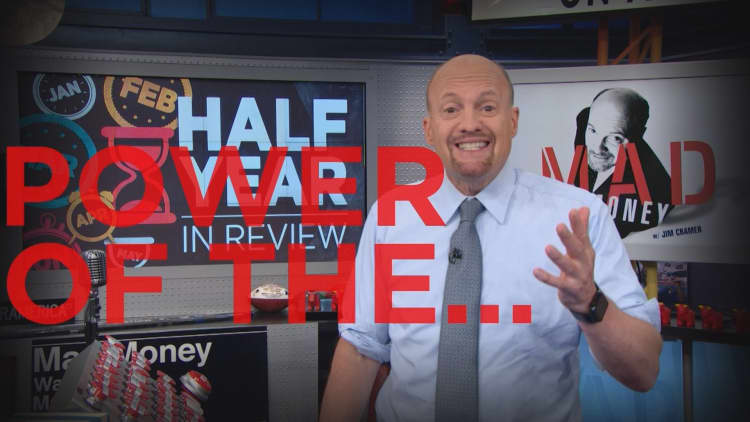
Now that the market has officially entered the second half of the year, Jim Cramer took a moment to review two of the worst sectors in the — the technology and financial stocks.
Technology stocks were up a mere 1.3 percent for the first half of 2016. Cramer found this surprising, as information technology accounts for approximately 20 percent of the S&P.
"When money is flowing into tech stocks, the whole market levitates, and that is something we saw in the recent rally over the past couple of weeks. But when tech flatlines, the averages tend to languish, too," the "Mad Money" host said.
Many investor hopes were dashed this year with financial stocks. In December, the Federal Reserve raised interest rates for the first time in eight years, with the expectation that it would raise four more times in 2016. That would have been very positive for the banks, which earn money from customer deposits as the Fed tightens.
More than six months later, there have been no rate hikes and it is unclear if the Fed will act again soon because of global economic uncertainty
"The financials were just plain bad, which is exactly what you would expect in an environment with low rates and few deals," Cramer said.
It is very rare that the averages can sustain an endlessly bullish move, and Cramer says rallies only end in two ways: with a big ugly decline or if stocks become exhausted.
"Let's stay vigilant. Take off some obvious gains, because no one ever got hurt taking a profit. But then let the rest ride, wagering that if the market really gets hit, the buyers who have been patiently waiting will finally decide to pull the trigger," Cramer said.
Cramer frequently refers to the Standard & Poor's proprietary short-range oscillator to take the pulse of the market. Typically the short-range oscillator stays within five points of zero, which is neutral. When it goes over five, Cramer becomes nervous.
On Tuesday night, the oscillator hit 10. It indicated a level of danger to Cramer, that stocks are severely overbought.
However, no indicator is ever 100 percent correct. Cramer has seen extreme overbought readings before that have worked themselves off over a course of a few days. But by that same token, sometimes stocks can keep plunging.
That is why Cramer recommended investors remain disciplined and trim some positions, because otherwise it would be greedy.
One stock riding high was General Mills, which is up 24 percent this year following the decision to remove artificial ingredients and make all of its cereals gluten free.
When Cramer interviewed General Mills CEO Ken Powell on "Squawk on the Street" on Wednesday and asked him what prompted him to make these changes, he said he simply listened to the customer.
"These companies are giving the customer what she wants, and in the stock market, just like in retail, the customer is always right," Cramer said.
Gold miner Randgold Resources has been slapped with five downgrades in 2016, yet the stock refused to dull its shine, and is up an astounding 94 percent this year.
Cramer explained the run, stating that the strength in Randgold is about more than just the underlying commodity.
"I used to see this pattern a lot back at my old hedge fund, and it typically meant that big institutional money managers had fallen in love with a stock," Cramer said.
Normally when a stock is hit with a wave of downgrades, it tends to be crushed. Randgold continued climbing as if nothing happened, which caught Cramer's attention.
Cramer is always on the lookout for game-changing technology that changes the industry it is in. Sometimes that means going off the tape to review privately held companies that could impact publicly traded competition.
BloomThat is a private San Francisco company that is going after the $4 billion flower business. Its website and mobile app allows customers to send bouquets nationwide, with same-day delivery in Los Angeles, New York and San Francisco.
What makes this company unique is that it cut out the florists. The company's initial strategy was to partner with local florists and outsource delivery. However, the strategy proved to be costly as BloomThat was burning approximately $500,000 a month and had only $1.6 million in the bank. With only three months left, the co-founders spent two months figuring out how to reconfigure the business.
The end result yielded in a strategy to train growers on the farms on how to wrap the bouquets, which brought expenditures down from $500,000 a month to $15,000. As a result, the company was profitable for the first half of 2016.
To learn more, Cramer spoke with BloomThat's CEO David Bladow, who explained the transformation of the company.
"It's really hard to figure things out on the fly as a start-up. You're figuring out disruptive new channels for distribution, new channels to grab new customers. It really was about breaking it down and making sure that the distribution that we have going sending our flowers through makes sense, and we make money on each transaction — which is sort of a novel thing when it comes to start-ups these days," Bladow said.
In the Lightning Round, Cramer gave his take on a few caller favorite stocks:
Blackstone Group: "BX or KKR, we could be talking to any one of these companies. They all need to have some equity offerings freed up. I'm not going to cut and run on Blackstone though. Too smart guys."
Coresite Realty: "I like Equinix more. We did a big number on those, and I think that is the best one in the game."



